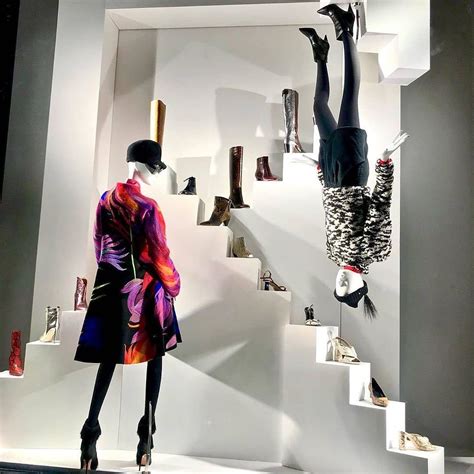Fashion merchandising is an integral part of the ever-evolving fashion industry, playing a crucial role in how trends are identified, products are promoted, and consumer demand is met. In this blog post, we will delve into the diverse and dynamic field of fashion merchandising, exploring its key components, functions, and opportunities.
From understanding the basics of fashion merchandising to unraveling the role of fashion merchandisers in the industry, we will break down the essential aspects of this career path. We will also compare fashion merchandising with fashion designing, shedding light on the distinctions between the two fields.
Additionally, we will discuss the key skills required for a successful career in fashion merchandising, as well as the latest trends and forecasting techniques that drive the industry forward. Effective visual merchandising techniques and product presentation strategies will also be explored, along with the importance of sustainable fashion in merchandising.
Lastly, we will uncover the plethora of career opportunities available in fashion merchandising, providing valuable insights for aspiring professionals in the fashion industry. Join us on this journey as we explore the essence of fashion through the lens of merchandising.
Table of Contents
Understanding Fashion Merchandising
Fashion merchandising is a crucial aspect of the fashion industry, involving the process of promoting, buying, and selling fashion products. It requires a deep understanding of consumer behavior, market trends, and the ability to forecast future demands. The role of a fashion merchandiser is to ensure that the right products are available at the right time and place, in order to maximize sales and profitability. This involves a combination of analytical, creative, and strategic skills to effectively manage and promote fashion products.
One of the key aspects of fashion merchandising is the ability to identify and understand consumer preferences and trends. This involves analyzing market research, sales data, and consumer behavior to forecast future demands and plan product assortments. A successful fashion merchandiser should have a keen eye for aesthetics and the ability to translate trends into profitable product assortments.
In addition to forecasting and product assortment planning, fashion merchandisers also play a crucial role in establishing pricing strategies and promotional activities. They work closely with designers, buyers, and marketers to develop effective promotional campaigns and pricing strategies that attract and retain customers.
Overall, an understanding of fashion merchandising is essential for anyone looking to pursue a career in the fashion industry, as it involves a combination of analytical, creative, and strategic skills to successfully manage and promote fashion products.
Role of Fashion Merchandisers in the Industry
When it comes to the fashion industry, the role of fashion merchandisers is crucial. These professionals are responsible for identifying the latest trends, forecasting future trends, and determining the best way to present products in the marketplace.
In addition to keeping up with the latest fashion trends, fashion merchandisers also have to have a strong understanding of consumer behavior and preferences. They need to be able to anticipate what consumers will want next and create strategies to meet those needs.
Furthermore, fashion merchandisers play a key role in working with manufacturers and suppliers to ensure that the right products are available at the right time and in the right quantities. Their ability to manage inventory and distribution is essential for the success of fashion brands and retailers.
Overall, the role of fashion merchandisers in the industry is multi-faceted and essential for the success of fashion businesses. From trend forecasting to inventory management, these professionals are at the heart of the fashion industry.
Fashion Merchandising vs. Fashion Designing
When it comes to the fashion industry, there are numerous career paths one can take. Two popular options are fashion merchandising and fashion designing. While both are integral parts of the industry, they have different roles and require different skill sets.
Fashion merchandising involves the business aspect of the fashion industry. Merchandisers are responsible for analyzing consumer buying patterns, predicting future trends, and ensuring that the right products are available at the right time. They work closely with buyers and suppliers to determine which products to stock and how to market them.
Fashion designing, on the other hand, focuses on the creative aspect of the industry. Designers are responsible for creating new clothing and accessory designs, often based on the latest trends and consumer demands. They use their artistic talent to sketch, drape, and create prototypes of their designs.
While both careers require a passion for fashion, fashion merchandisers need to have strong analytical and negotiation skills, as well as a solid understanding of business and marketing principles. Fashion designers, on the other hand, need to be creative, detail-oriented, and have a strong understanding of textiles and garment construction.
Key Skills for a Fashion Merchandiser
One of the key skills for a fashion merchandiser is a keen eye for detail. The ability to spot trends and identify potential opportunities in the market is essential for success in this role. A merchandiser must also have strong analytical skills to interpret sales data and make informed decisions about product assortment and pricing.
In addition, effective communication skills are crucial in this field. Fashion merchandisers often work closely with designers, buyers, and retailers, and must be able to clearly convey their ideas and strategies. Strong negotiation skills are also important, as merchandisers must work with suppliers and vendors to secure the best deals and terms for their products.
Another important skill for a fashion merchandiser is the ability to think creatively and innovatively. Developing unique and compelling product presentations and promotional strategies requires out-of-the-box thinking. Merchandisers must also stay up to date with the latest industry trends and consumer behaviors to remain competitive in the market.
Finally, a fashion merchandiser must possess strong organizational and time management skills. Coordinating product development, sourcing, and distribution requires careful planning and attention to detail. The ability to prioritize tasks and meet deadlines is essential for success in this fast-paced and dynamic industry.
Fashion Merchandising Trends and Forecasting
In the fast-paced world of fashion, staying ahead of the latest trends and forecasting future trends is essential for success in the industry. Fashion merchandising trends and forecasting play a crucial role in helping retailers and brands anticipate consumer demand and stay competitive in the market.
One of the most important trends in fashion merchandising is the shift towards sustainability and ethical practices. Consumers are becoming increasingly conscious of the environmental and social impact of their purchasing decisions, and as a result, fashion retailers are under pressure to adopt more sustainable practices in their supply chains and product offerings.
Another key trend in fashion merchandising is the rise of online shopping and digital retail experiences. With the growth of e-commerce and social media, fashion merchandisers need to adapt their strategies to meet the demands of the digital consumer. This includes creating visually appealing online storefronts, leveraging social media influencers, and using data analytics to personalize the shopping experience.
Forecasting future trends in fashion merchandising requires a keen understanding of consumer behavior, economic indicators, and cultural influences. Fashion merchandisers must stay attuned to global events, social movements, and technological advancements to anticipate shifts in consumer preferences and purchasing patterns.
Effective Visual Merchandising Techniques
Visual merchandising is an important aspect of the fashion industry, as it involves creating captivating displays that attract customers and drive sales. One effective technique for visual merchandising is to use color blocking to create visually appealing displays. By grouping clothing and accessories by color, it creates a visually striking effect that draws customers in and encourages them to make a purchase.
Another effective technique is to incorporate props and signage into displays to create a themed environment. This can help tell a story and create an emotional connection with the customer, leading to increased engagement and ultimately, sales. Additionally, using lighting strategically can highlight certain products and create a focal point within the display, drawing the customer’s attention and guiding their eye towards specific merchandise.
Furthermore, implementing a rotating merchandise display can keep the store looking fresh and new, encouraging repeat visits from customers. Engaging in visual storytelling by creating displays that tell a narrative can also leave a lasting impression on customers and make the shopping experience more memorable.
The Art of Product Presentation
Product presentation is a crucial element in the fashion industry, as it plays a significant role in attracting customers and influencing sales. Fashion merchandisers are responsible for ensuring that products are presented in an appealing and visually captivating manner to entice potential buyers.
Effective product presentation involves understanding the target audience and creating displays that resonate with their preferences and lifestyles. This can involve using creative and innovative techniques to showcase the products in a way that captures attention and communicates the brand’s identity.
Visual storytelling is an integral part of product presentation, as it allows merchandisers to convey a narrative through the display. This can involve using color schemes, textures, and props to create a cohesive and visually impactful presentation that draws customers in and encourages them to make a purchase.
Ultimately, mastering the art of product presentation requires a keen understanding of consumer behavior, trends, and the ability to think outside the box to create captivating displays that leave a lasting impression on potential buyers.
Fashion Merchandising Strategies for Success
The world of fashion merchandising is competitive and ever-changing, making it crucial for professionals in the industry to adopt effective strategies for success. In order to thrive in this fast-paced field, fashion merchandisers must stay ahead of trends, understand consumer behavior, and develop strong business acumen.
One key strategy for success in fashion merchandising is to build strong relationships with suppliers and manufacturers. By maintaining close connections with these key players in the industry, merchandisers can ensure timely production and delivery of products, as well as negotiate favorable terms and pricing.
Effective inventory management is also essential for success in fashion merchandising. By closely monitoring sales data and customer preferences, merchandisers can optimize their stock levels and minimize the risk of overstock or stockouts, leading to improved profitability.
In addition, utilizing data and analytics to inform merchandising decisions can give professionals a competitive edge. By analyzing consumer behavior, market trends, and sales performance, merchandisers can make informed decisions about product assortments, pricing strategies, and promotional campaigns.
Sustainable Fashion in Merchandising
In today’s fashion industry, sustainability has become an increasingly important issue, and this extends to the world of fashion merchandising. Sustainable fashion focuses on creating clothing and accessories in an environmentally and socially responsible manner, and it is a growing trend among consumers. As a result, fashion merchandisers are tasked with finding and promoting sustainable fashion options to meet the demands of this conscientious market.
One key aspect of sustainable fashion in merchandising involves working with brands and designers who prioritize eco-friendly and ethical practices. This may include using organic or recycled materials, reducing waste in their production processes, or ensuring fair labor practices throughout their supply chain. By partnering with these companies, fashion merchandisers can help promote and support sustainable initiatives within the industry.
Furthermore, sustainable fashion merchandising also involves educating consumers about the importance of making environmentally conscious choices in their fashion purchases. Merchandisers can use their platform to highlight the benefits of sustainable fashion and encourage their customers to make more mindful buying decisions. Additionally, they can work to debunk the myth that sustainable fashion is less stylish or trendy, and instead showcase the many fashionable and on-trend options available in the sustainable fashion market.
As society’s awareness and concern for environmental and social issues continue to grow, the role of sustainable fashion in merchandising will only become more significant. By embracing sustainable practices and principles, fashion merchandisers can play a vital part in shaping a more eco-friendly and ethical future for the fashion industry.
Career Opportunities in Fashion Merchandising
Are you passionate about fashion and have a keen eye for trends? A career in fashion merchandising might be the perfect fit for you. With the ever-evolving fashion industry, there are a multitude of career opportunities available for individuals with a strong understanding of consumer behavior, market trends, and business acumen.
One popular career path in fashion merchandising is becoming a fashion buyer. Fashion buyers are responsible for selecting and purchasing merchandise for retail stores, department stores, or online platforms. They work closely with suppliers, designers, and merchandisers to curate a selection of products that appeal to the target demographic and align with the overall brand image.
Another exciting career opportunity in fashion merchandising is visual merchandising. Visual merchandisers are responsible for creating eye-catching displays and layouts that showcase products in an appealing way. They play a crucial role in attracting customers and driving sales by creating an enticing shopping environment.
For those with a flair for marketing and a passion for fashion, a career in fashion marketing and advertising could be an ideal fit. Fashion merchandisers can work in advertising agencies, PR firms, or directly for fashion brands to develop and execute marketing campaigns, manage social media channels, and analyze consumer data to drive brand awareness and sales.






